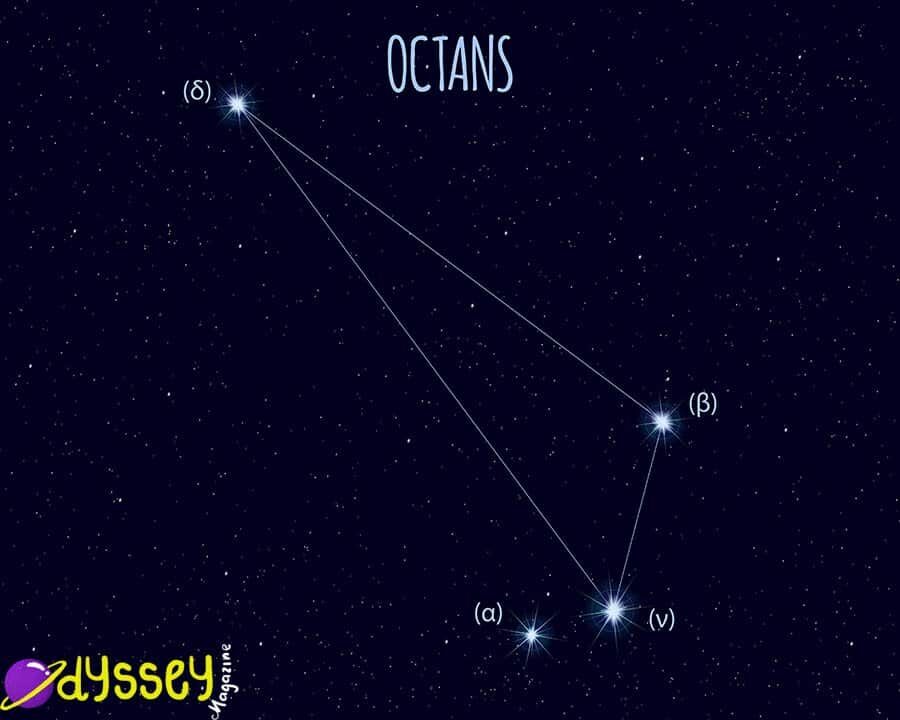Octans Constellation | The Octant (Circle)
Known for actually being one of the hardest constellations to see in the night sky, Octans is actually the pole star of the Southern hemisphere. Finding Octans is a great way to be able to find the South Celestial Pole in the night sky, but as it is quite faint, it can be pretty difficult to spot all of its stars. Let’s look at everything you need to know about Octans.
Octans Constellation
- Bordered By; Tucana, Indus, Pavo, Apus, Chamaeleon, Mensa, Hydrus.
- Named after; The Octant
- Declination; -90°
- Brightest Star; Nu Octantis
- Best seen; September
- Size rank; 50th
- Constellation family; Lacaille
- Pronunciation; OCK-TANS

What is Octans named after?
Whilst a quadrant is a quarter of a circle and a sextant is a sixth of a circle, Octans takes its name from an octant, which is an eighth of a circle in Latin. Most other constellations can be traced back to Greek and Babylonian times, but actually, although Octans takes its name from Latin in a round-about way, it isn’t direct. It is actually name after the octant device, which is a navigational instrument.
Who founded the Octans Constellation?
Octans forms part of the Lacaille family of constellations, which were all discovered by Nicolas Louis de Lacaille. They were named after his devices that he used whilst travelling the world – this includes other constellations like Sculptor and Telescopium. Although a Frenchman, all of Lacaille’s constellations that we currently recognise were discovered in the 1750s whilst he was in South Africa.
How can I see Octans in the sky?
If you’re looking to find Octans, then you’ll need to be located in the Southern hemisphere to do this. The best time of year to see the constellation is during the month of September. All of the other constellations that surround Octans, like Pavo, are all relatively faint and small, so it can be difficult to find them.
Main stars of Octans
Octans is a constellation with relatively few stars, and most of them are quite faint and difficult to see. Though it’s not impossible to find, and here’s the major stars of Octans.

- Nu Octantis (ν) – The brightest star in the constellation is Nu Octanis. Although it’s the brightest start, that isn’t saying much, as it is still relatively faint when compared to other constellations. It is a binary star, made up of a combination of an orange giant with a red dwarf star as the secondary. Recently, astronomers have theorized that Nu Octantis is actually a large planet, with a greater mass than Jupiter (which is the largest in our solar system).
- Beta Octantis (β) – Another binary system star, Beta Octantis is the second brightest within the constellation. This means that although it is very faint, it can still be spotted without a telescope. Astronomers estimate that it’s around half a billion years old, and it makes up another one of the corners of the Octans triangle.
- Delta Octantis (δ) – The final corner of the triangle is made up of the star Delta Octantis. It is an orange giant start that actually has a mass that is very similar to our own Sun. It also has a very similar age to our own Sun too, with an estimated age of around 4.5 billion years.
The Wrap Up
All in all, this is a small and faint constellation, but if you’re in the Southern hemisphere, then it’s definitely worth looking out for. Although all of the constellations in this area are very faint, it only has three major stars to identify, which makes it one of the easiest to find. The bad news is that you’ll never see it if you’re in the Northern hemisphere, as it sets below the horizon and is impossible to see from a Northern location.